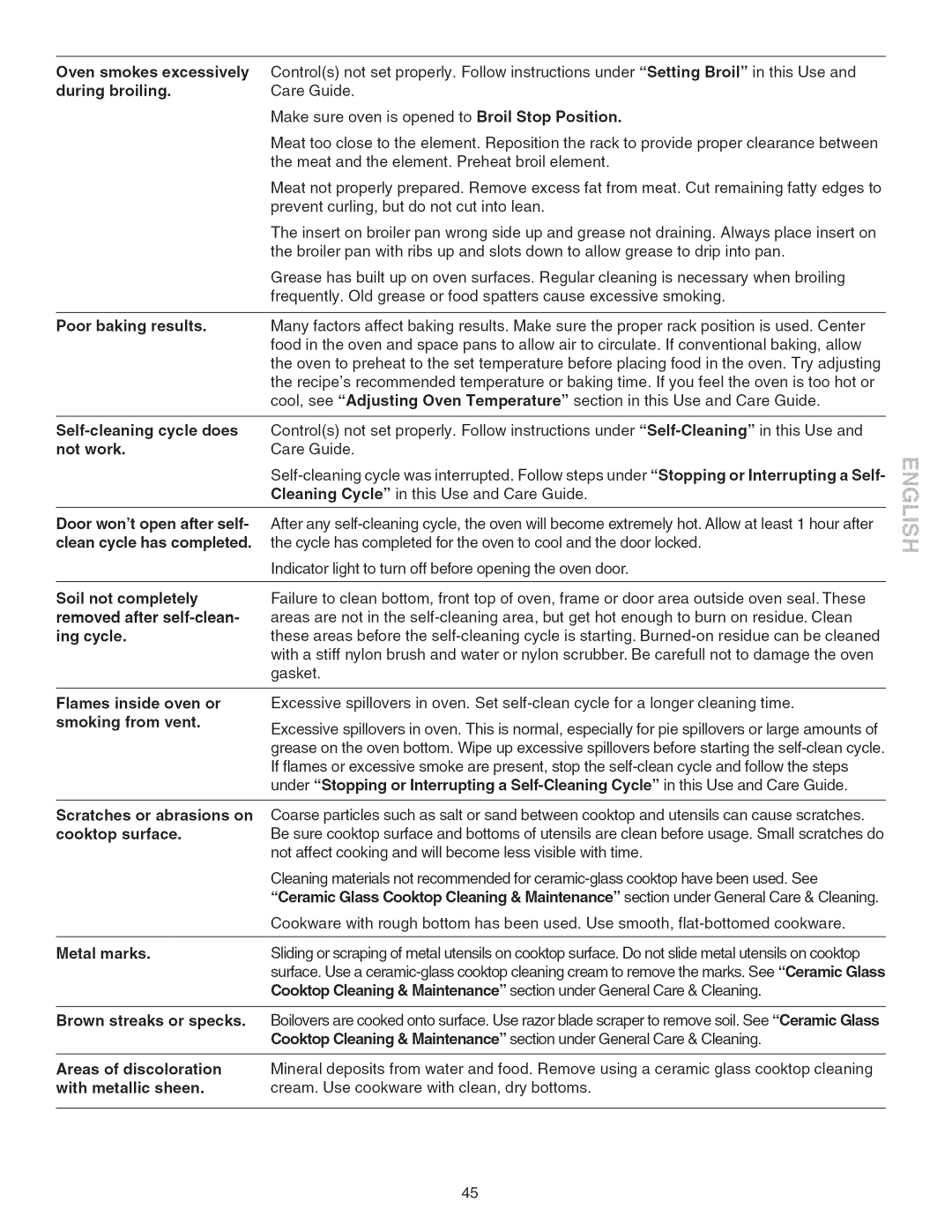
Oven smokes excessively during broiling.
Poor baking results.
Self=cleaning cycle does not work.
Door won't open after self=
clean cycle has completed.
Soil not completely
removed after self=clean=
ing cycle.
Flames inside oven or smoking from vent.
Scratches or abrasions on
cooktop surface.
Metal marks.
Brown streaks or specks.
Areas of discoloration with metallic sheen,
Control(s) not set properly. Follow instructions under "Setting Broil" in this Use and Care Guide.
Make sure oven is opened to Broil Stop Position.
Meat too close to the element. Reposition the rack to provide proper clearance between the meat and the element. Preheat broil element.
Meat not properly prepared. Remove excess fat from meat. Cut remaining fatty edges to prevent curling, but do not cut into lean.
The insert on broiler pan wrong side up and grease not draining. Always place insert on the broiler pan with ribs up and slots down to allow grease to drip into pan.
Grease has built up on oven surfaces. Regular cleaning is necessary when broiling frequently. Old grease or food spatters cause excessive smoking.
Many factors affect baking results. Make sure the proper rack position is used. Center food in the oven and space pans to allow air to circulate. If conventional baking, allow the oven to preheat to the set temperature before placing food in the oven. Try adjusting the recipe's recommended temperature or baking time. If you feel the oven is too hot or cool, see "Adjusting Oven Temperature" section in this Use and Care Guide.
Control(s) not set properly. Follow instructions under "Self=Cleaning" in this Use and Care Guide.
After any | _............iiil | |
| ||
the cycle has completed for the oven to cool and the door | locked. | ........iii |
Indicator light to turn off before opening the oven door. |
|
|
Failure to clean bottom, front top of oven, frame or door area outside oven seal. These |
| |
areas are not in the |
| |
these areas before the |
| |
with a stiff nylon brush and water or nylon scrubber. Be carefull not to damage the oven |
| |
gasket. |
|
|
Excessive spillovers in oven. Set |
| |
Excessive spillovers in oven. This is normal, especially for pie spillovers or large amounts of |
| |
grease on the oven bottom. Wipe up excessive spillovers before starting the |
| |
If flames or excessive smoke are present, stop the |
| |
under "Stopping or Interrupting a | in this Use and Care Guide. |
|
Coarse particles such as salt or sand between cooktop and utensils can cause scratches. Be sure cooktop surface and bottoms of utensils are clean before usage. Small scratches do not affect cooking and will become less visible with time.
Cleaning materials not recommended for
Cookware with rough bottom has been used. Use smooth,
Sliding or scraping of metal utensils on cooktop surface. Do not slide metal utensils on cooktop surface. Use a
Boilovers are cooked onto surface. Use razor blade scraper to remove soil. See "Ceramic Glass Cooktop Cleaning & Maintenance" section under General Care & Cleaning.
Mineral deposits from water and food. Remove using a ceramic glass cooktop cleaning cream. Use cookware with clean, dry bottoms.
45
